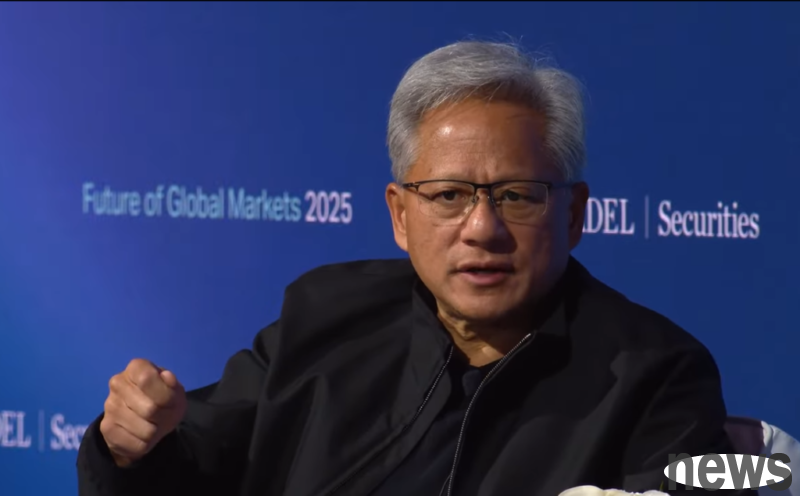
NVIDIA (NVIDIA) CEO Jensen Huang said that AI factories and general generative computing will be the key drivers of the next wave of growth. In this regard, NVIDIA not only created the infrastructure for the AI revolution, but also shifted the computing paradigm from storage and retrieval to 100% generative.
In a symposium held by Citadel Securities, Huang Jensen deeply analyzed the rise of NVIDIA and the nature of the AI revolution. First of all, Huang Renxun looked back to 1993, when NVIDIA was founded, and pointed out that it was the era of Moore's Law in the PC and CPU revolution. He observed that general-purpose technologies such as CPUs, while versatile, were often not good at solving "very difficult" problems. Therefore, the core of NVIDIA later was to enhance general-purpose computing through "accelerated computing", which is a more domain-specific solution.
In addition, NVIDIA must invent new technologies and markets at the same time, and the probability of this task is essentially close to zero. However, NVIDIA eventually succeeded in building a modern 3D graphics gaming ecosystem and realized that the underlying mathematics of 3D graphics (simulating reality) are closely related to physics simulation. Since then, NVIDIA invented the CUDA platform, which was a great invention that allowed NVIDIA to systematically shift from a vertically concentrated industry to general computing. The emergence of CUDA has enabled researchers and scholars around the world to significantly relax the computing limitations of Moore's Law. Huang Renxun emphasized that it is extremely rare to create a new computing platform (such as a platform other than ARM or x86), and it took NVIDIA nearly 30 years to do it.
As for the turning point for the AI revolution, it happened in the early 2010s. Huang Renxun pointed out that NVIDIA was implementing the "CUDA Everywhere" strategy and actively promoted CUDA to scientists and researchers. Between 2011 and 2012, NVIDIA's key contribution was the invention of a new solver library, cuDNN. But a more forward-looking observation is that deep neural networks (through backpropagation, long short-term memory networks and Transformer architecture) are general function approximators that can learn almost any function. Therefore, NVIDIA decided to reinvent every layer of the computing stack (chip, system, software).
NVIDIA launched the world’s first AI factory DGX-1 in 2016. Huang Renxun said that the design goal of the AI factory is to provide a system with the highest input and output per unit of energy, the largest scale, and the lowest cost. He calls the AI factory a "factory" rather than a data center because customers are making money from it.
In this way, NVIDIA’s advantage is that they are the only company that can design the entire infrastructure at the same time, including GPU, CPU, network, switches and all software. Through this co-design, NVIDIA is able to break through the limitations of Moore's Law and deliver approximately tenfold improvements in performance every year while maintaining software compatibility. Huang Renxun emphasized that the input and output per unit of energy (Token generation rate/unit energy) is a KPI that is underestimated by Wall Street, and it directly determines the customer's income.
Huang Jen-Hsun refuted the idea that the current AI craze was the dot-com bubble of 2000. He pointed out that today's AI has transformed hundreds of billions of dollars of business (such as search, recommendation systems) of very large-scale companies (such as Google, Amazon, Meta). The next wave of opportunities lies in "digital labor" (Agentic AI) and "Physical AI" (Physical AI).
The digital workforce (Agentic AI) includes AI engineers, AI nurses, AI accountants, AI marketers, etc. This will complement and enhance the enterprise market, creating a multi-trillion dollar opportunity. These AIs need to continuously "think" and generate results, so they need an AI factory as the basis for calculations. In terms of physical AI, it includes “concrete” AI such as self-driving taxis and robotic arms. Because physical AI utilizes general intelligence that is highly similar to digital AI, it is applied in different specific forms. For example, to achieve future development of robots, three computing facilities are needed: a training model (AI factory), a virtual learning world (Omniverse), and the robot's own brain.
Finally, when it comes to sovereign AI, Huang Renxun believes that no country can afford to outsource all national data and turn back to input smart models. Therefore, countries should import, purchase, and at the same time build their own national wisdom. Regarding the U.S. export controls on China, he pointed out that policymakers should be cautious because policies that are unfavorable to China may also harm the United States. NVIDIA's market share in the Chinese market has dropped from 95% to 0%, which he believes is a mistake. Because, in order to ensure that global developers continue to adopt the US technology stack, policies need to be carefully balanced.
Huang Renxun concluded that the future computing paradigm will be 100% generative, and all content will be generated instantly instead of being retrieved from storage. Currently, only hundreds of billions of dollars of AI infrastructure have been built around the world. For an industry that may require trillions of dollars of investment every year, this is just the beginning. He suggested that corporate information officers should immediately invest in building their own AI employees (digital employees) and train them to match the company's expertise and culture.